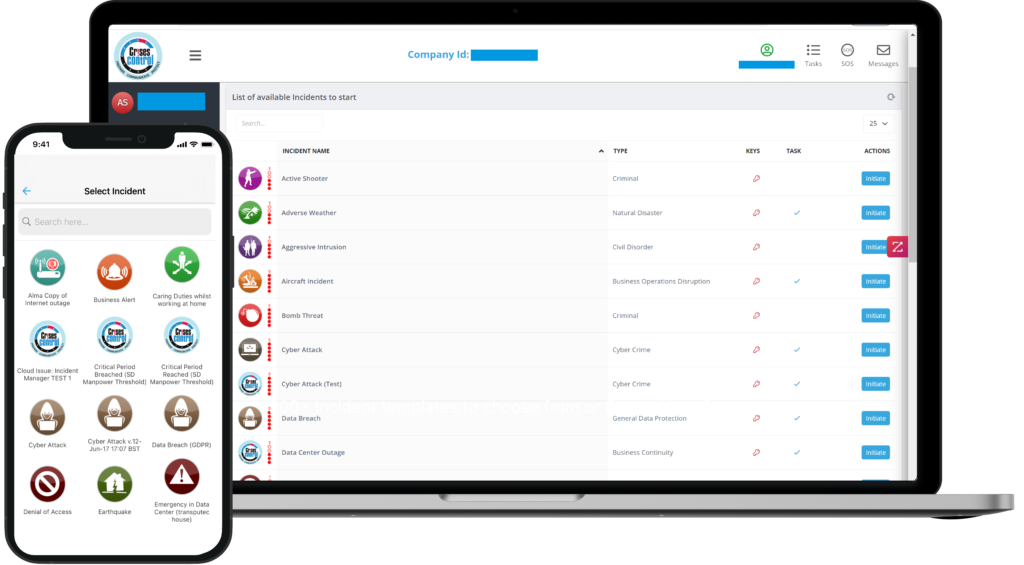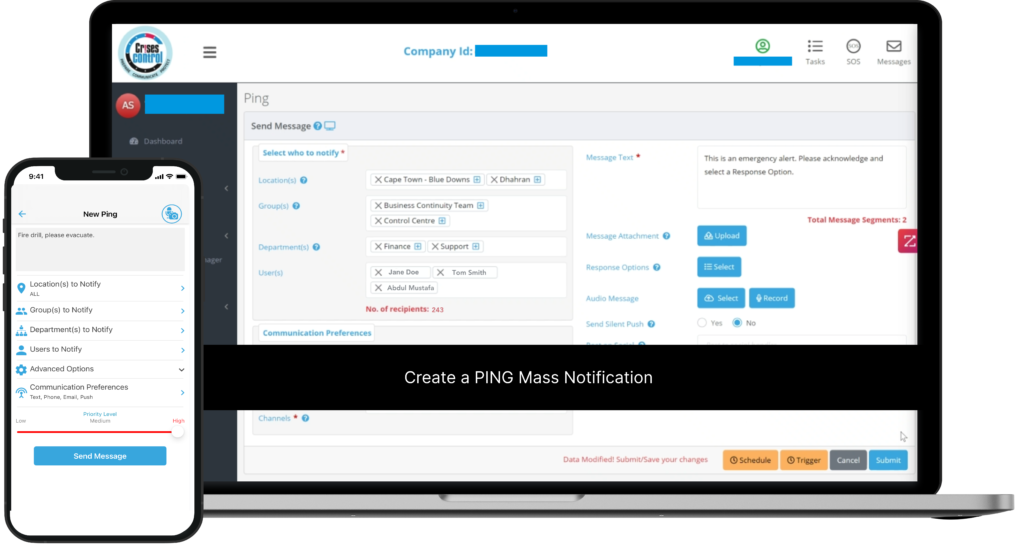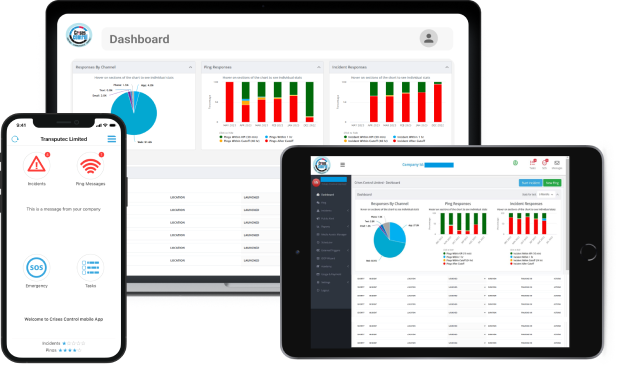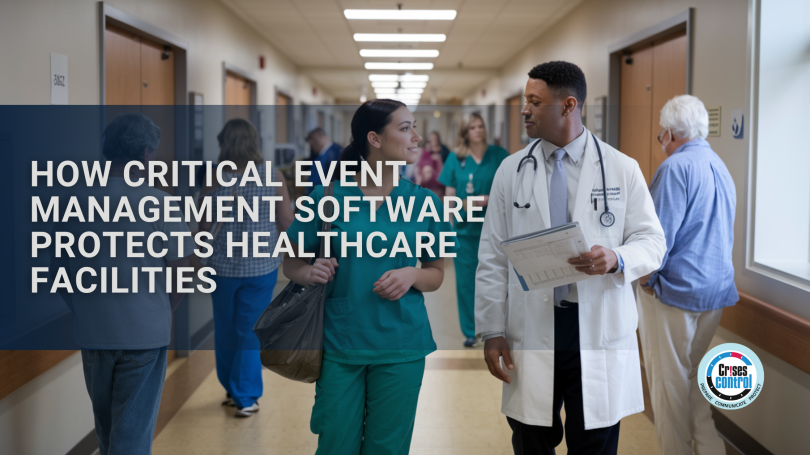Written by Anneri Fourie | Crises Control Executive
When something goes wrong in a hospital, every second matters. A delayed response could be the difference between saving a life and losing one. Whether it’s a power cut during surgery, a cyberattack on patient systems, or a violent incident in A&E, healthcare facilities need to respond immediately and effectively. There’s no room for hesitation.
This is where Critical Event Management Software (CEMS) becomes a vital part of a hospital or care facility’s emergency preparedness. It’s not just about sending alerts, it’s about managing the entire incident, from the first warning to the final recovery step.
In this blog, we explore why healthcare settings are especially vulnerable to critical events, what the risks are of sticking with outdated processes, and how platforms like Crises Control can help healthcare providers stay prepared, protect lives, and meet compliance requirements.
Why Healthcare Facilities Are Particularly at Risk
Hospitals and care homes are complex environments. They operate around the clock, often at capacity, and deal with both physical and digital vulnerabilities. Unlike most workplaces, the consequences of failure here are immediate and potentially fatal.
Healthcare facilities are especially at risk of:
- Medical emergencies that require instant coordination between clinical and support teams
- Power or equipment failures that interrupt procedures like surgery or dialysis
- Cyberattacks on patient records, hospital systems, and supply chain networks
- Acts of violence or aggression against staff and patients
- Natural disasters such as flooding or storms that disrupt services and threaten infrastructure
What makes these situations even harder to manage is the need for a rapid, coordinated response—often across departments, shifts, or even different sites.
Why Traditional Response Methods Fall Short
Many healthcare organisations still rely on manual processes and fragmented systems to manage critical events. These include paper-based protocols, ad-hoc WhatsApp groups, and disconnected alerting systems. Unfortunately, these outdated methods come with serious drawbacks:
- Delayed responses: Staff waste valuable time trying to find and activate the right plan
- Lack of visibility: Decision-makers can’t see what’s happening in real time
- Poor coordination: Actions overlap or get missed due to lack of shared information
- Inadequate documentation: Difficulties in proving compliance or learning from incidents
In short, it creates chaos when clarity is needed most.
How Critical Event Management Software Improves Healthcare Response
A good Critical Event Management Software platform brings all emergency procedures, communications, and response tasks into one place. Instead of juggling spreadsheets, radios, emails, and phone calls, everything runs through a single, integrated solution.
Key capabilities of Crises Control include:
- Instant mass notifications via SMS, voice call, email, and mobile app
- Pre-built workflows tailored to specific healthcare scenarios
- Role-based task tracking, so everyone knows what to do and when
- Integrations with alarms, sensors and access controls for automatic incident triggering
- Real-time dashboards for oversight and operational control
- Detailed audit trails to support regulatory compliance and post-incident reviews
This level of automation and transparency means decisions are made faster, tasks are completed more reliably, and incidents are resolved with fewer delays.

Interested in our Incident Management Software?
Customise your Crisis Incident Management Software to meet your specific needs with our flexible tools & stay connected and informed during the crisis and incident management process
Five Real-World Incidents—and How Crises Control Helps
Let’s look at five realistic scenarios that healthcare providers face, and how a tool like Crises Control helps turn disorder into order.
1. Power Cut in a Surgical Suite
Imagine a power failure mid-operation. There’s no time to waste. With Crises Control:
- Alerts are triggered automatically via integration with the building’s systems
- Key staff—surgeons, theatre support, facilities—receive instant alerts
- Generators kick in, task lists are activated, and everyone can track recovery progress in real time
The result? No need for frantic calls or searching for protocols. The system does the thinking so staff can focus on care.
2. Ransomware Attack on Patient Records
Cyberattacks are growing in both number and impact. If access to electronic patient records is lost, care is compromised. With Crises Control:
- The IT team can launch an emergency cyber response workflow via the mobile app—even if the main network is down
- Secure messages are sent to key stakeholders and actions begin immediately
- Steps to isolate systems, notify authorities, and protect backup data are tracked and completed
It ensures the hospital isn’t paralysed during a digital crisis.
3. Active Shooter or Violent Threat On-Site
Sadly, violence in healthcare settings is on the rise. When something serious happens, staff need to act fast. With Crises Control:
- Any staff member can discreetly raise an alarm using the in-app SOS panic button
- Lockdown protocols are triggered instantly, security teams are alerted, and the emergency response team receives clear task lists to carry out the protocol quickly and seamlessly.
- Staff in high-risk areas are guided step-by-step through what to do
This helps prevent panic, protects lives, and speeds up the response.
4. Infectious Disease Outbreak
COVID-19 made it clear: coordinated response is everything. With Crises Control:
- Scenario-based plans for outbreaks are activated instantly
- Alerts go out about PPE levels, isolation areas, or visitor restrictions
- Actions are tracked to ensure consistent application across all departments
Having a digital plan means everyone is on the same page, and decisions can be audited later.
5. Severe Flooding or Natural Disaster
A storm damages a healthcare facility and displaces staff. With Crises Control:
- Team members check in using the app’s geolocation feature
- Critical recovery tasks—like relocating patients or securing medicines—are assigned and tracked
- Visitors can scan a QR code upon arrival to opt in to live SMS updates, ensuring they stay informed during an incident, while internal teams manage communications through targeted mass notifications.
The software helps ensure people and processes aren’t lost in the chaos.
Why Crises Control Is Built for Healthcare
Crises Control is designed with healthcare’s unique pressures in mind. It’s used by private hospitals, care homes, and clinics across the UK and beyond.
Key healthcare-specific features include:
- Predefined templates for clinical, infrastructure, and digital incidents
- Secure, always-on cloud infrastructure—even when other systems are down
- Mobile-first design for use on the ward or in transit
- Dashboards that provide instant oversight for leadership and emergency response teams
- Post-incident reporting tools to support audits, investigations, and litigation
It’s a system that fits around your teams and processes, not the other way round.
Interested in our Ping Mass Notification Software?
Efficiently alert everyone in seconds at scale with our Mass Notification Software – PING, get the message out fast and ensure rapid response and recovery.

Supporting Compliance and Governance
Healthcare providers must comply with strict rules—from NHS Digital and ISO 22301 to GDPR and HIPAA (for those working internationally). During an incident, poor documentation or a lack of control can lead to serious consequences.
Crises Control supports compliance by:
- Capturing every action and decision in a timestamped digital log
- Keeping sensitive data secure with role-based access controls
- Generating automated reports for audits, investigations, and board reviews
- Enforcing protocols through predefined workflows, so nothing gets missed
That means healthcare providers don’t just respond effectively, they can also prove they did.
Building Real Resilience, Not Just Reaction
Technology is a powerful tool, but true resilience is about people, preparation, and practice. Crises Control helps build that resilience into daily operations, making emergency readiness a normal part of the culture, not just something that gets dusted off when things go wrong.
With Crises Control, your organisation can:
- Detect problems earlier
- Act faster, with fewer errors
- Communicate clearly, across every department
- Learn from every incident to improve future performance
It’s not about replacing people. It’s about supporting them with the tools they need to make better decisions, under pressure, when it matters most.
Take the Next Step Towards Preparedness
Healthcare providers are facing more frequent and more complex challenges. Power cuts, cyber threats, disease outbreaks, and physical security incidents are no longer rare events—they’re part of the landscape.
That’s why being prepared isn’t optional.
Crises Control gives you the tools to move from code red to complete control.
You’ll get a platform built specifically for healthcare, helping you stay ready, protect lives, and meet your obligations.
Ready to see how it works in your organisation?
Get a free personalised demo and discover how Crises Control can help you strengthen emergency preparedness from the inside out.
Request a FREE Demo

